Using WordPress as a CMS for Clients
As WordPress has developed into version 3, it is slowly becoming a top choice for CMS solutions for designers and developers. It provides great flexibility and it’s easy to work with. As a client, they receive a great open source solution with a lot of control over what they can achieve without any level of web knowledge.
This means that WordPress has moved on a long way from being heavily biased on a personal blogging system. But to use it successfully as a client solution, it must be implemented with the client and their needs at the forefront of the build. There are a few things to take in to consideration when doing this, and this article looks into a few of these issues.
1. WordPress’s Built-In CMS Capabilities
The WordPress platform now offers a range of options for the client including the ability to create pages and blog posts, allowing page links, themes and commenting. For us, pages are the one feature really making this system stand out. Allowing the client to manage non-blog content, in a more standardised page layout.
This feature is a fantastic solution and with the added bonus of being able to style each page in a different way to really diversify the client solution. Creating a range of templates for your client means it will add longevity to your site build, keeping your client happy for longer, especially if thought is put in to your main templates to allow for expandability.
With a well thought out page template, the client will need to know no coding languages or technical terminology in order to update the page.
2. Client Training
For designers and developers, WordPress is pretty straight forward to use especially if you are using it regularly, however for a client, no matter how simplistic a UI is, they will still be quite overwhelmed if they are not used to working in a CMS styled environment.
So we always promote training along with our WordPress website builds. If the site is relatively simple and straight forward, it should take between 2-3 hours to train a client to use the system, and we would recommend no more than 2 clients per training session. With a simple stepped procedure and with a dash of practical, most clients will pick up all the knowledge they need within this time.
3. No More Custom Fields, in Come Custom Posts
Custom fields were a great feature of WordPress and they open up all kinds of possibilities to create additional elements to a page template, however they did require an element of coding knowledge from a user.
The new WordPress build now allows the Custom Post ability. This means we as designers and developers can build a full custom environment for the client, creating within the interface, built in elements to fulfil a specific requirement. For example, instead of say needing the client to select a custom filed called (Image icon) then having the client upload and find the image maniacally through the media manager, then copying and pasting HTML, we can simply create an upload feature for the user, allowing a one click upload and a quick and clean solution.
This custom post feature is one of our favourite additions to the WordPress CMS.
4. Create A Range of Bespoke Page Templates
As previously mentioned, creating a range of page templates for a client increases the life and longevity of a website, as the client will be able to add quite a few diverse range of page layouts without having to keep getting updates to there website.
This also adds an extra level of interest to a site, meaning each page does not look identical. Also, page templates can allow you to secure elements of the design that might be accidentally changed or altered by the client.
5. Set up a solid base of Plugins
There are a few key plugins we would recommend installing for a clients benefit. These plugins will again, allow a longer life for your website and reduce the risk of anything going wrong while a client is using it. We would recommend on any WordPress build installing:
All In One SEO – This plugin allows users to manually add Keywords, Descriptions and Titles to each of their posts and pages, meaning with a little training, each client can make sure there site is fully optimizes the way they want it.
Next Gen Gallery – The native WordPress media library is good, very good in fact, but the Next Gen Gallery plugin adds an extra level or filtering, which is great for client who want to organize their images and media in a more ordered fashion.
Akismet – This is a pre-installed plugin on the WordPress build which is a comment spam blocker. Activating this for a client on their behalf is a great way to keep them happy and avoid them complaining about spam.
WordPress Database Backup – This is a simple database backup plugin which means if anything goes wrong with the client website, it automatically saved a version of the clients database monthly/weekly or however often you need it to.

Leave a Reply